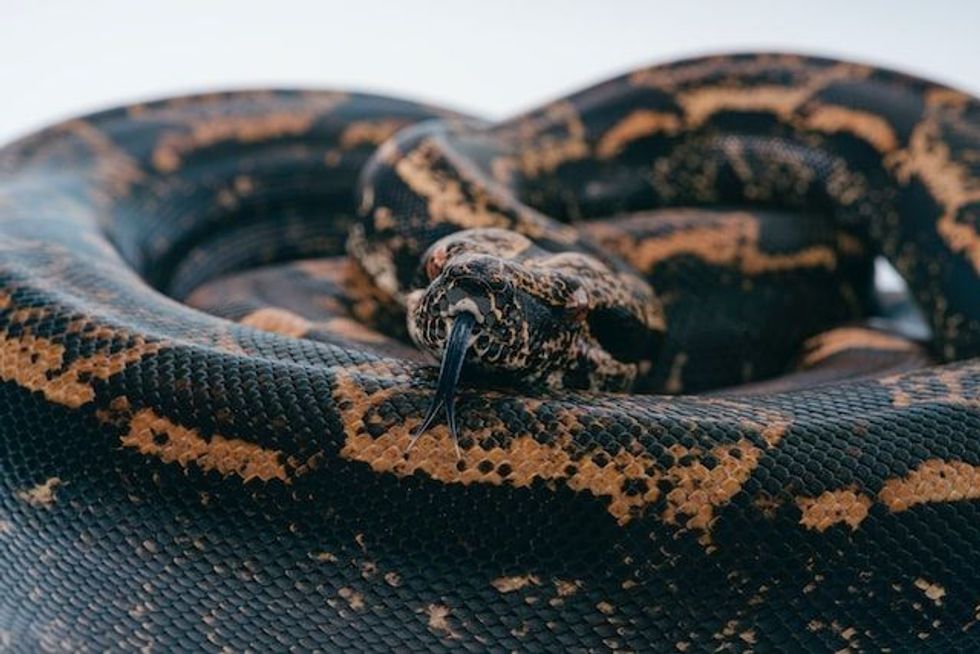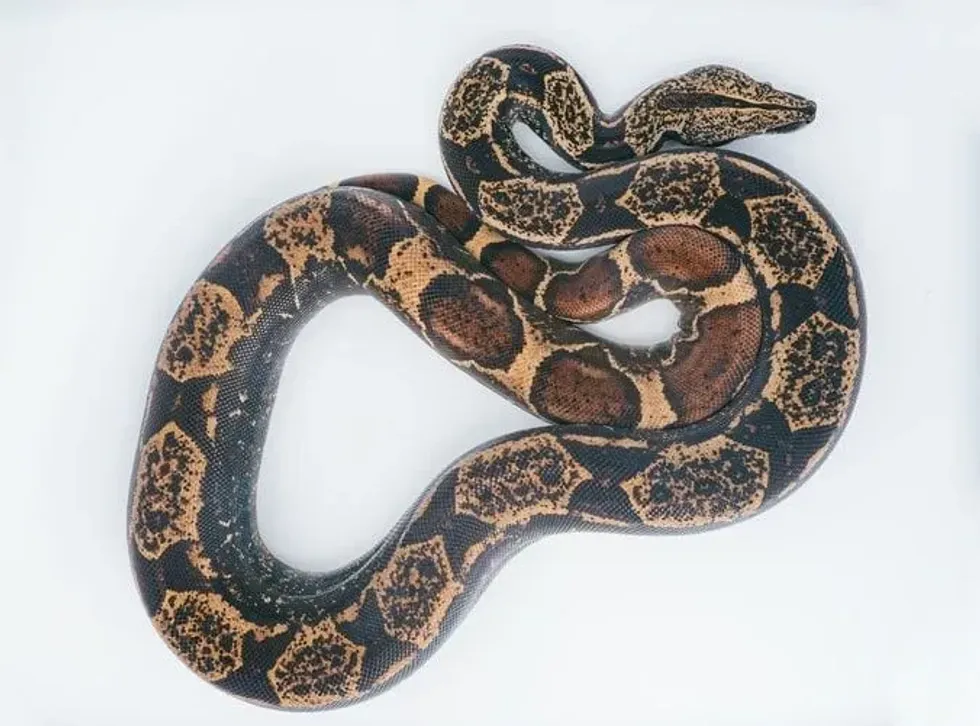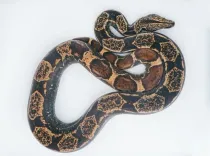Fun Boa Snakes Facts For Kids

The boa snake is a common name amongst the species of nonvenomous constricting wild snakes with an approximate number of 40 species in this family. However, the Mascarene, or split-jawed, boas and dwarf boas should not be mistaken for the true family of boas.
As per their size and appearance, the wild boa constrictor is a distinctively large snake but quite moderate in size as compared to other species of large snakes such as the anaconda, subspecies of pythons like the Burmese python, green anaconda, reticulated python, and the like.
They can grow up to the size of 3 ft – 13 ft (0.91 m – 3.96 m) in their own habitats.
However, another distinguishing feature of this species of snakes is sexual dimorphism, meaning, the females are larger in girth and length than the male boa constrictors with the female boas reaching up to a size of 7 and 10 ft (2.1 and 3.0 m).
The wild boa constrictor is usually heavy-bodied with the mature ones weighing up to 60 lb (27 kg).
Some snakes from this species can even reach a weight of 100 lb (45 kg) but it is quite rare.
Boa constrictors are strong and powerful species of snakes who are also notable for their stealthy hunting skills which are heightened by the tropical climates they inhabit in Central and South America, where they usually hunt at night.
While on a hunt, they are known to ambush their prey and then swallow it whole digesting it with their strong stomach acids.
They normally don't hunt to eat for a few weeks after eating.
Boa constrictors are also noted for their constant growth all throughout their entire lives, which can span from 20 to 30 years. They are also known to live and hunt and live alone.
Boa Interesting Facts
What type of animal are boas?
Boas are large, heavy snakes who prey on various smaller creatures and even some larger mammals like pigs. They are bulky predatory creatures and they prefer to not chase prey, instead, they wait for the prey to get to them which is followed up by the boa constricting their prey before devouring it.
What class of animal do boas belong to?
Boas belong to the Reptilia class and are related to all the other snakes which reside on our planet. This makes them a distant relative of the ancient lizards as well.
How many boas are there in the world?
There are 40 subspecies of true boas in this world that are appropriately distributed mainly throughout Southern America and some parts of Asia and Africa. Some species of boas are endangered while a few can be found in huge numbers in the wild.
Where do boas live?
The highest number of boas can be found in parts of South America. There are species found in North and Central America as well as in the Caribbean.
Some species are found in isolated parts of Southeastern Europe as well as some areas which come under Asia Minor. There are many sub-species of boas found in the Northern regions of Africa, Central Africa, East Africa, Madagascar, and near the Arabian Peninsula.
The boas heavily infest the desert and jungle regions of Central Asia and Southwestern Asia, often being noticed in countries like India and Sri Lanka.
They can also be found in the Moluccas, New Guinea, Melanesia, and Samoa. Boas are well distributed throughout America, Asia, and Africa.
What is a boa's habitat?
Boa constrictors like the red-tailed boa snakes, red boa snakes, island boa snake, rosy boa snakes, sand boa snakes rainbow boa, emerald tree boa snakes, other tree boas, and the like live in rainforests and semi-desert habitats generally, with most of the boas being found in the jungles and grasslands.
The boa constrictor snakes prosper in marshes and dense jungles due to the affluent amount of food and space to consider as their territory.
They are known to also haunt mountains and areas in high altitudes. They can also be found near rivers and streams as they are highly skilled swimmers.
Baby boas are quite arboreal and even enjoy spending time on trees which generally stops when they get bulkier and heavier with age.
Who do boas live with?
The boa constrictor snakes generally live alone and it is the same throughout their life unless they are mating.
How long do boas live?
Boa constrictor snakes can live up to 40 years which makes it a long-term job if one decides to domesticate a boa.
How do they reproduce?
They reproduce during the dry season, specifically between the months of April and August. Boas have been noticed to be ovoviviparous, which means that the females give birth to live young baby snakes.
Male boas are polygynous and might mate with many females boas for a small duration of time. When it is about deciding on which male to mate with, it is only after multiple males brawl over a contested female and only after winning, the victorious snake gets to mate with the female boa.
The male and female coil up against each other with the male wrapping his tail around the female. The gestation period of a pregnant boa constrictor depends greatly on the local temperature of their habitats.
It has also been reported that boas are capable of reproducing asexually through a process known as parthenogenesis.
Mother boa constrictors usually give birth to nearly 60 newborns at one time. Baby boa constrictors are on their own ever since they are born and the knowledge of hunting as well as protecting themselves from predators is inbuilt in their system.
The diet of a baby boa constrictor usually changes with growth. The bigger the size, the bigger the preferred choice of prey.
What is their conservation status?
They are not critically endangered due to a lot of the boa snakes being affluent in nature but some species or boas are becoming extinct due to humans killing them for their beautiful ornate skin and even due to procuring their organs for unproven medicinal benefits or properties.
Boa Fun Facts
What do boas look like?

Boas are a species of large and heavy snakes that have ornate skin with various patterns. They come in all sorts of colors ranging from yellow, green, brown, fawn, grey, and even white.
They have different patterns on them which can be brown, red, or black. They are big snakes and can generally be recognized from afar due to their distinguishing features.
How cute are they?
Big boas attract snake lovers from all over the world but young boas and baby boas are so cute that almost anyone would find them cute. These young and tiny little cute creatures with comparably bigger heads than the rest of the body have a beautiful diamond or randomized patterning.
They look soft and the larger head makes the rest of their body look really adorable.
How do they communicate?
Boa constrictor snakes like most other snakes communicate by releasing pheromones which help in gathering essential information like sex, age, and if the female boa constrictor wants to mate in their habitat.
How big are boas?
Boa constrictors grow up to 3 ft – 13 ft (0.91 m – 3.96 m), and their length usually depends on prey and habitat locality.
The usual size of mature female boas is between 7 and 10 ft (2.1 m and 3.0 m) whereas males are 6 to 8 ft (1.8 m and 2.4 m). Significantly smaller than anacondas, boa constrictors can grow up to 13 feet long and weigh more than 100 pounds.
Females commonly exceed 10 ft (3.0 m), particularly in captivity, where lengths up to 12 ft (3.7 m) or even 14 ft (4.3 m) can be seen.
How fast can boas move?
One thing common amongst boa constrictors is that they are good swimmers and non-venomous snakes of the Boidae genus in the wild but not as fast as anacondas despite their compact size.
This species of snake is faster when they are young but with age, they start getting heavier which in turn makes them slower and lazier in their own habitat.
They start waiting for their prey in burrows of other mammals or camouflage themselves to surprise and trap their prey instead of proactively looking for creatures to hunt.
In captivity, it is seen that boa constrictor snakes can be fast enough to hunt and kill the live prey that has been offered to them as food but generally they stay waiting for prey to fall into their scaly trap.
How much do boas weigh?
Common boa constrictors are heavy snakes, and the largest ones can weigh up to 60 lb (27 kg). Females are the bigger sex and they commonly weigh more, generally ranging from 22 to 33 lb (10 to 15 kg). There have been many exceptions where boas have been reported to exceed 100lb, which is close to 45kg.
What are their male and female names of the species?
Male and female boa constrictors like the emerald tree boa of the Amazon and others are not distinguished by any specific name but the position of a body part named lubricated probe. The lubricated probe of female drops in one to three scales and that of a male drops in nine to fifteen scales.
What would you call a baby boa?
Neonates or newborns are the common names for baby boa snakes. Female boa constrictors give birth to live young baby snakes in the Amazon rainforest.
What do they eat?
Mainly a large variety of animals and small mammals inhabiting the Amazon, ranging from small to medium-sized birds, large lizards, birds, opossums, bats, mongooses, rats, and squirrels are consumed by the carnivorous boa constrictor. Boa constrictors from the family Boidae that are bred and kept at the Smithsonian's National Zoo, eat mice, rats, and chicks.
They are also known to have been able to consume monkeys, pigs, and other smaller animals.
Are they dangerous?
Yes, they are quite dangerous with bigger variants being capable of injuring even humans. Generally, the boa constrictors stick to smaller mammals but even though they are generally not life-threatening to humans, they can fatally hurt a human being with their bite or constricting nature.
Would they make a good pet?
In captivity, some species of boa constrictors become calm and even friendly towards humans. Generally, boa constrictors are quite aggressive towards smaller mammals and are not friendly with other creatures. But some boa constrictors have been known to be domesticated and kept by humans throughout history.
Did you know...
Boa constrictors are not the largest snake species amongst the larger snakes like anacondas in Central and South America.
The largest boa constrictor, however, was documented non-stretched dry skin that measured up to 14.6 ft (4.45 m) minus the head and has been deposited at The Bavarian State Collection of Zoology.
Another fun fact about the boa constrictors is that unlike most other species of large snakes that kill their prey by suffocation, boa constrictors use the method of ambush.
Once they pounce upon a living prey, they wind their bodies around it to compress the vital organs of the victim and to also check for a pulse and monitor the heartbeat.
This is how they determine when the prey is dead and ready to be consumed.
How have boa snakes adapted?
The boa constrictor snakes have made considerable adaptations over the years. These species of boa constrictors have remnants of legs which are termed 'pelvic spurs' which protrude like claws attached to their underbellies.
The boa constrictors are therefore considered a primitive species of snakes that have evolved from ancestors who were four-legged. However, they are known to still possess two lungs unlike other species of snakes that have evolved to only have one lung.
Do boa snakes make good pets?
The boa constrictor is a common name you'll hear in the pet trade of pet snakes. Boa constrictor species of snakes may be intimidating to keep as pets.
However, many snake or reptile enthusiasts keep boa constrictor species like tree boas, a rainbow boa, and other species of constrictor boa. They are a common pet in the pet trade of the pet snakes in the world, with the rainbow boa snakes being the most exotic amongst them.
But a boa constrictor can live for a very long time being 20-30, or even up to 40 years. Hence living with pet boa snakes is a big commitment.
Here at Kidadl, we have carefully created lots of interesting family-friendly animal facts for everyone to discover! Learn more about some other reptiles including the cottonmouth snake and the rattlesnake.
You can even occupy yourself at home by drawing one of our boa coloring pages.
We Want Your Photos!
More for You
Sources
https://en.wikipedia.org/wiki/Boa_constrictor
https://www.britannica.com/animal/boa-constrictor
https://www.britannica.com/animal/boa-snake-family
Bachelor of Arts specializing in Journalism and Mass Communication, Postgraduate Diploma in Sports Management

Moumita DuttaBachelor of Arts specializing in Journalism and Mass Communication, Postgraduate Diploma in Sports Management
A content writer and editor with a passion for sports, Moumita has honed her skills in producing compelling match reports and stories about sporting heroes. She holds a degree in Journalism and Mass Communication from the Indian Institute of Social Welfare and Business Management, Calcutta University, alongside a postgraduate diploma in Sports Management.
Bachelor of Science specializing in Computer Science

Chandan ShuklaBachelor of Science specializing in Computer Science
With a Bachelor's degree in Computer Science from Aryabhatta College, University of Delhi, Chandan is a skilled and passionate technophile. He has completed a machine learning training program and is adept in various programming languages. He has been working as a content writer for two years while also striving to become a proficient tech professional.
Disclaimer
1) Kidadl is independent and to make our service free to you the reader we are supported by advertising. We hope you love our recommendations for products and services! What we suggest is selected independently by the Kidadl team. If you purchase using the Buy Now button we may earn a small commission. This does not influence our choices. Prices are correct and items are available at the time the article was published but we cannot guarantee that on the time of reading. Please note that Kidadl is a participant in the Amazon Services LLC Associates Program, an affiliate advertising program designed to provide a means for sites to earn advertising fees by advertising and linking to Amazon. We also link to other websites, but are not responsible for their content.
2) At Kidadl, we strive to recommend the very best activities and events. We will always aim to give you accurate information at the date of publication - however, information does change, so it’s important you do your own research, double-check and make the decision that is right for your family. We recognise that not all activities and ideas are appropriate for all children and families or in all circumstances. Our recommended activities are based on age but these are a guide. We recommend that these ideas are used as inspiration, that ideas are undertaken with appropriate adult supervision, and that each adult uses their own discretion and knowledge of their children to consider the safety and suitability. Kidadl cannot accept liability for the execution of these ideas, and parental supervision is advised at all times, as safety is paramount. Anyone using the information provided by Kidadl does so at their own risk and we can not accept liability if things go wrong.
3) Because we are an educational resource, we have quotes and facts about a range of historical and modern figures. We do not endorse the actions of or rhetoric of all the people included in these collections, but we think they are important for growing minds to learn about under the guidance of parents or guardians.







